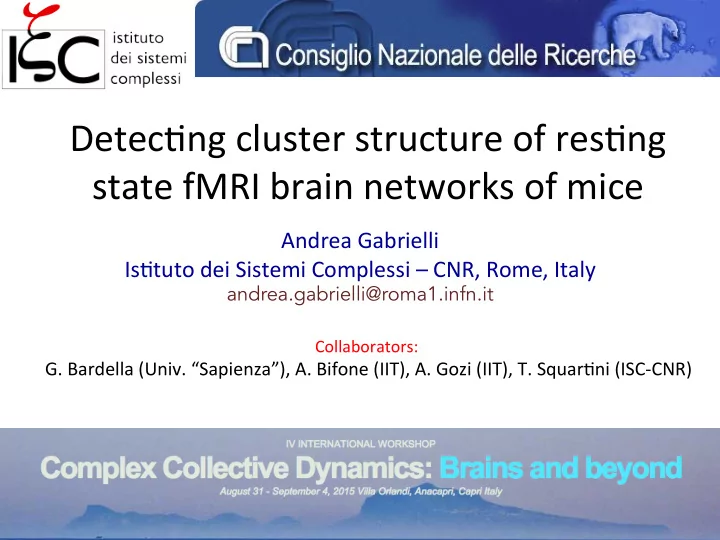

Detec%ng ¡cluster ¡structure ¡of ¡res%ng ¡ state ¡fMRI ¡brain ¡networks ¡of ¡mice ¡ Andrea ¡Gabrielli ¡ Is%tuto ¡dei ¡Sistemi ¡Complessi ¡– ¡CNR, ¡Rome, ¡Italy ¡ andrea.gabrielli@roma1.infn.it Collaborators: ¡ ¡ G. ¡Bardella ¡(Univ. ¡“Sapienza”), ¡A. ¡Bifone ¡(IIT), ¡A. ¡Gozi ¡(IIT), ¡T. ¡Squar%ni ¡(ISC-‑CNR) ¡ ¡ ¡
Outline ¡ ¡ ¡ Data ¡set ¡ • ¡collected ¡by ¡applying ¡fMRI; ¡ • ¡collected ¡by ¡considering ¡res%ng-‑state ¡mice ¡brains. ¡ ¡ Our ¡approach ¡(are ¡network ¡theory-‑based ¡tools ¡useful?) ¡ • ¡comparison ¡with ¡null ¡models ¡for. ¡. ¡. ¡; ¡ • ¡. ¡. ¡. ¡percola%on ¡analysis; ¡ • ¡. ¡. ¡. ¡community/modules ¡detec%on ¡analysis. ¡ ¡ Results ¡ • ¡modular ¡structure: ¡detectable; ¡ • ¡func%onal ¡modules: ¡not ¡explained ¡by ¡a ¡null ¡model ¡constraining ¡the ¡ correla%ons ¡distribu%on; ¡ • beUer ¡agreement ¡using ¡blockmodels. ¡ 15/09/15 ¡ Brains ¡and ¡beyond, ¡Anacapri ¡ 2 ¡
¡ Data ¡set ¡ • 41 ¡mice ¡brains ¡[male ¡20–24 ¡week ¡old ¡C57BL/6J ¡(B6); ¡Charles ¡River, ¡Como, ¡Italy]; ¡ • ¡54 ¡macro-‑regions ¡(Brodmann's ¡areas) ¡subdivided ¡into ¡lec ¡and ¡right ¡part, ¡ ¡ ¡ ¡ ¡ ¡ ¡ ¡i.e. ¡27 ¡regions ¡of ¡interest ¡(ROI) ¡for ¡each ¡hemisphere; ¡ • ¡1 ¡fMRI ¡%me ¡series ¡per ¡region ¡(300 ¡%me ¡steps ¡long ¡ ~ ¡300 ¡secs). ¡ • Summing ¡up: ¡54 ¡%me ¡series ¡for ¡each ¡of ¡the ¡41 ¡mice. ¡ • Mice ¡were ¡anaesthe%zed ¡with ¡isoflurane ¡(5% ¡induc%on), ¡intubated ¡and ¡ar%ficially ¡ ven%lated ¡under ¡2% ¡isoflurane ¡maintenance ¡anesthesia. ¡All ¡experiments ¡were ¡ performed ¡with ¡a ¡7.0 ¡T ¡MRI ¡scanner ¡(Bruker ¡Biospin, ¡Milan) ¡using ¡an ¡echo ¡planar ¡ imaging ¡(EPI) ¡sequence ¡with ¡the ¡following ¡parameters: ¡TR/TE ¡1200/15 ¡ms, ¡ ␣ ip ¡angle ¡ 30°, ¡matrix ¡100 ¡× ¡100, ¡field ¡of ¡view ¡2 ¡× ¡2 ¡cm2, ¡24 ¡coronal ¡slices, ¡slice ¡thickness ¡0.50 ¡ mm, ¡300 ¡volumes ¡and ¡a ¡total ¡rsfMRI ¡acquisi%on ¡%me ¡of ¡6 ¡min. ¡ ¡ 15/09/15 ¡ Brains ¡and ¡beyond, ¡Anacapri ¡ 3 ¡
Data: ¡fMRI ¡%me-‑series ¡at ¡res%ng ¡condi%on ¡ For ¡each ¡region ¡of ¡each ¡mouse ¡a ¡300 ¡%me-‑steps ¡long ¡BOLD ¡fMRI ¡signal ¡X i (t) ¡is ¡measured ¡ • accumbens ¡nucleus; ¡ • ¡anterio-‑dorsal ¡hippocampus; ¡ • ¡amygdala; ¡ • ¡. ¡. ¡. ¡ 15/09/15 ¡ Brains ¡and ¡beyond, ¡Anacapri ¡ 4 ¡
Region-‑region ¡correla%on ¡matrix ¡construc%on ¡ (single ¡mouse) ¡ Posi%ve ¡correla%ons ¡are ¡more ¡numerous ¡than ¡nega%ve ¡correla%ons ¡and ¡the ¡former ¡ are ¡characterized ¡by ¡higher ¡(absolute) ¡values ¡than ¡the ¡laUer. ¡ 15/09/15 ¡ Brains ¡and ¡beyond, ¡Anacapri ¡ 5 ¡
1 st ¡level ¡clustering ¡analysis: ¡dendrogram ¡plot ¡ Usually ¡binariza%on ¡implies ¡the ¡introduc%on ¡of ¡ad ¡hoc ¡thresholds: ¡we ¡analyze ¡directly ¡C ij ¡ (Jaccard ¡distance, ¡ aUrac%ve ¡an%corr.) ¡ A ¡first ¡hint ¡of ¡modular ¡structure ¡appears ¡as ¡a ¡nested ¡structure ¡ 15/09/15 ¡ Brains ¡and ¡beyond, ¡Anacapri ¡ 6 ¡
The ¡dendrogram ¡tool ¡make ¡evident ¡a ¡coherent ¡and ¡nested ¡cluster ¡structure ¡ Example ¡ • An ¡example ¡is ¡provided ¡by ¡areas ¡13, ¡14, ¡27, ¡28, ¡29, ¡30, ¡45 ¡and ¡46 ¡(i.e. ¡the ¡whole ¡ cingulate ¡cortex, ¡the ¡whole ¡motor ¡cortex, ¡the ¡whole ¡medial ¡prefrontal ¡cortex ¡and ¡the ¡ whole ¡primary ¡somatosensory ¡cortex, ¡respec%vely). ¡ • While ¡they ¡give ¡origin ¡to ¡a ¡8X8 ¡matrix ¡whose ¡average ¡value ¡is ¡approximately ¡ 0.85, ¡the ¡two ¡subgroups ¡composed ¡respec%vely ¡by ¡ ¡13, ¡14, ¡27, ¡29 ¡and ¡28, ¡30, ¡45, ¡ 46 ¡cons%tute ¡two ¡4X4 ¡sub-‑matrices ¡whose ¡average ¡value ¡is ¡around ¡0.95. ¡ • This ¡can ¡be ¡rephrased ¡by ¡saying ¡that, ¡within ¡the ¡same ¡group ¡of ¡areas ¡responding ¡ coherently ¡to ¡some ¡s%mulus, ¡there ¡exist ¡subgroups ¡responding ¡maximally ¡coherently, ¡ thus ¡iden%fying ¡func%onally ¡correlated ¡brain ¡modules. ¡ The ¡modular ¡structure ¡of ¡the ¡brain ¡clearly ¡appears ¡as ¡a ¡nested ¡structure ¡of ¡ highly ¡correlated ¡areas, ¡the ¡laUer ¡emerging ¡as ¡sub-‑matrices ¡of ¡smaller ¡size ¡ characterized ¡by ¡higher ¡correla%ons ¡values ¡than ¡the ¡background ¡ 15/09/15 ¡ Brains ¡and ¡beyond, ¡Anacapri ¡ 7 ¡
We ¡can ¡increase ¡informa%on ¡on ¡hierarchical ¡clustering ¡by ¡introducing ¡a ¡ dissimilarity ¡induced ¡by ¡correla%on ¡with ¡sign ¡(repulsive ¡an%-‑correla%ons) ¡ 15/09/15 ¡ Brains ¡and ¡beyond, ¡Anacapri ¡ 8 ¡
• Retaining ¡the ¡informa%on ¡on ¡the ¡correla%ons ¡sign ¡allows ¡one ¡to ¡clearly ¡dis%nguish ¡ posi%vely ¡correlated ¡groups ¡of ¡areas ¡from ¡the ¡nega%vely ¡correlated ¡ones, ¡thus ¡ improving ¡the ¡detec%on ¡of ¡brain ¡modules. ¡ ¡ Example ¡ • Areas ¡6, ¡23 ¡and ¡24 ¡(i.e. ¡the ¡lec ¡part ¡of ¡amygdala ¡and ¡the ¡whole ¡hypothalamus, ¡ respec%vely) ¡are ¡recognized ¡as ¡forming ¡a ¡group ¡of ¡highly ¡posi%vely ¡correlated ¡ areas, ¡interac%ng ¡with ¡the ¡rest ¡of ¡the ¡brain ¡via ¡quite ¡large ¡nega%ve ¡correla%ons: ¡ this ¡suggests ¡that ¡they ¡should ¡be ¡considered ¡as ¡(part ¡of) ¡a ¡separate ¡module. ¡ ¡ Non-‑trivial ¡to ¡observe ¡a ¡hierarchical ¡structure ¡in ¡less ¡evolved ¡animals ¡(e.g. ¡in ¡C. ¡ elegans ¡non ¡sign ¡of ¡hierachical ¡organiza%on ¡of ¡modules) ¡ 15/09/15 ¡ Brains ¡and ¡beyond, ¡Anacapri ¡ 9 ¡
Modularity ¡approach ¡ ¡ [See ¡M. ¡MacMahon, ¡D. ¡Garlaschelli, ¡Phys. ¡Rev. ¡X ¡ 5 , ¡021006 ¡(2015). ¡ M. ¡E. ¡J.Newman, ¡PNAS, ¡ 103 , ¡8577 ¡(2006)] ¡ Newman ¡modularity ¡with ¡corrected ¡null ¡model ¡for ¡correla%on ¡networks ¡ (Louvain’s ¡detec%on ¡algorithm) ¡ Only ¡three ¡modules ¡detected ¡ 15/09/15 ¡ Brains ¡and ¡beyond, ¡Anacapri ¡ 10 ¡
Standard ¡Percola%on ¡approach ¡ [see ¡Gallos ¡et ¡al., ¡PNAS ¡ 109 , ¡2825 ¡(2012) ¡for ¡“standard” ¡perc. ¡under ¡training ¡condi%ons] ¡ ¡ • The ¡abs ¡values ¡of ¡the ¡measured ¡correla%ons ¡are ¡listed ¡in ¡increasing ¡order; ¡ • star%ng ¡from ¡the ¡lowest ¡one, ¡each ¡of ¡them ¡is ¡chosen ¡as ¡a ¡threshold; ¡ • the ¡links ¡corresponding ¡to ¡the ¡correla%ons ¡below ¡the ¡threshold ¡are ¡removed; ¡ • the ¡size ¡of ¡the ¡giant ¡(largest) ¡component ¡is ¡measured ¡at ¡each ¡step. ¡ In ¡Gallos ¡et ¡al. ¡on ¡human ¡brain ¡at ¡voxel ¡level ¡under ¡strong ¡external ¡audio-‑visual ¡s%muli ¡ ¡ a ¡step-‑wise ¡behavior ¡is ¡observed ¡sugges%ng ¡a ¡hierarchical ¡mul%ple ¡transi%on ¡behavior ¡ ¡ Very ¡different ¡from ¡Erdos ¡Renyi ¡networks: ¡STEPS! ¡ • We ¡observe ¡a ¡similar ¡behavior ¡in ¡our ¡case ¡ • The ¡coarse-‑grained ¡nature ¡of ¡ROI ¡ permits ¡mul%ple ¡transi%on ¡detec%on ¡ also ¡at ¡res%ng ¡condi%on ¡ 15/09/15 ¡ Brains ¡and ¡beyond, ¡Anacapri ¡ 11 ¡
Recommend
More recommend